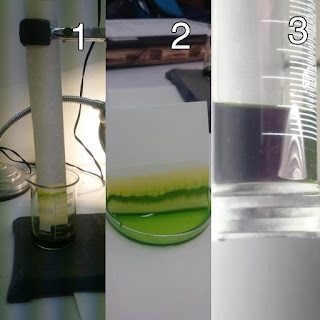Objective:
To do the process of chromatography (separate the pigments with ethanol)
Material:
- Mortar ans Pestle
- Funnel
- Scissors
- Graduated Cylinder
- Sand
- Beaker (250ml) or a petri dish
- Ethanol
- Calcium carbonate
- Spinachs
- Cellulose paper
PROCEDURE:
1. Take 6/7 leafs of spinacks and cut in small pieces with the scissors.
2. Put the small pieces inside the mortar with the spatula and put a little bit of sand inside de mortar.
3. With the spatula take calcium carbonate and put inside with the leafs and the sand.
4. Add 50 ml of ethanol.
5. You need to grind
6. Finally, you need to filter the mixture and extract the liquid.
- Cut a paper strip with the cellulose paper and put inside the beaker (with the liquid that we extract)
- Do the same with the petri dish, but you need to bend the cellulose paper.
- The liquid that you have in the graduated cylinder put in front of the light.
QUESTIONS:
1. Why do we add sand?To brake the cells, we brake the cloroplast.
2. Why do we add calcium carbonate?
Prevents the pigments degradation.
3. Which is the color of every pigment?
chlorophyll (verd), xanthophyll (yellow) and carotens (orange).
4. What adaptative purpose do different colored pigments serve for a plant?
to capture different light wavelengths
5. Why do they separate on the cellulose paper?
For the solubility
CALCULATE:




No comments:
Post a Comment